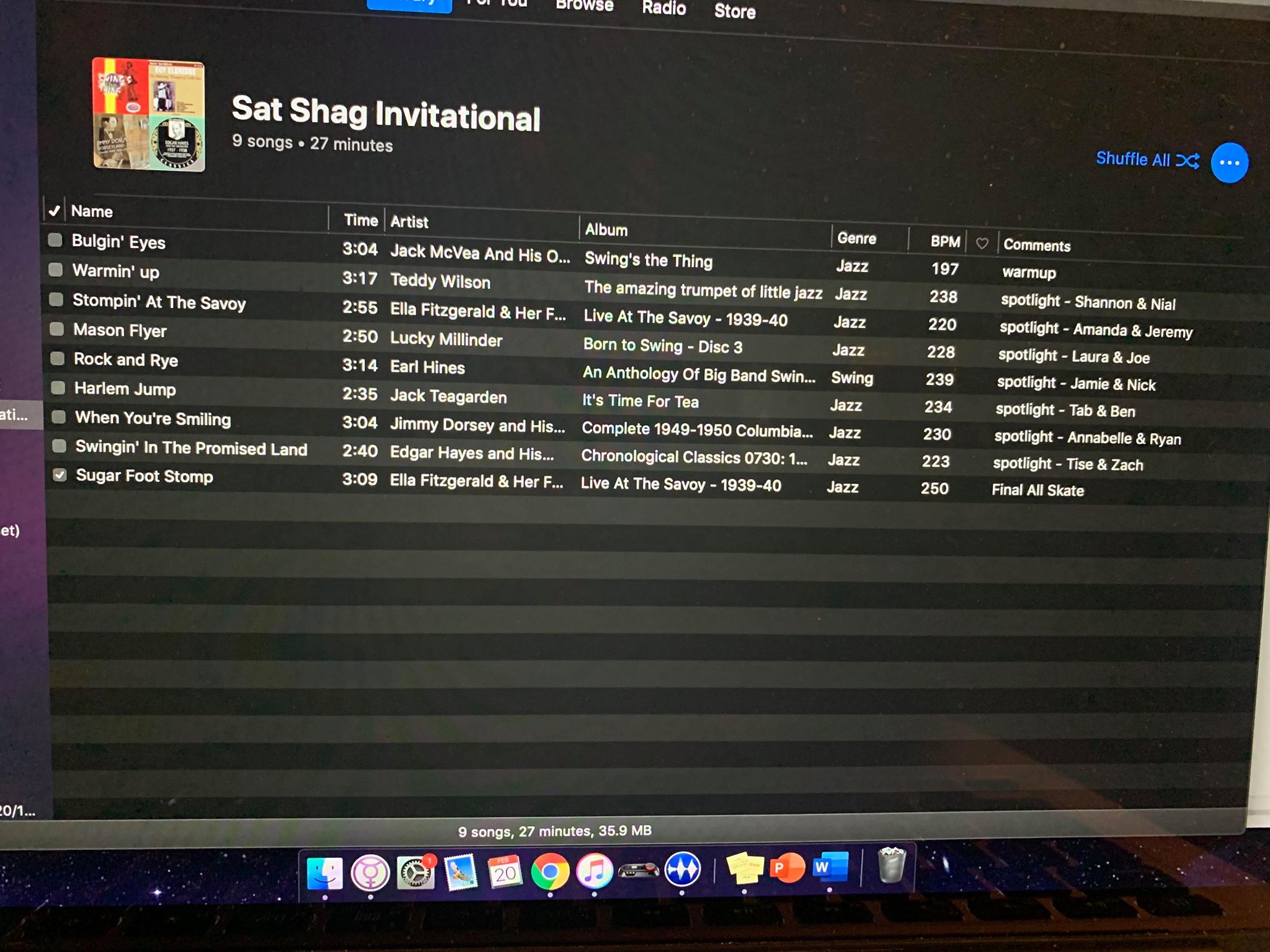The topic of Black inclusion in Lindy Hop and Blues has been an increased topic of discussion in the Lindy Hop and Blues the last few weeks. I wanted today to share the perspective of Odysseus Bailer, a professional actor from New York City who is also an avid DJ and dancer of both swing and blues. He has written about the matter and was kind enough to allow me to share his perspective on this blog.
APPRECIATION:
A : to grasp the nature, worth, quality, or significance of
B : to value or admire highly
C : to judge with heightened perception or understanding : be fully aware of
D : to recognize with gratitude
CULTURAL APPROPRIATION:
Often framed as cultural misappropriation, is a concept in sociology dealing with the adoption of the elements of a minority culture by members of the dominant culture. Using another culture’s artistic and religious traditions, fashion, symbols, language, and songs.
Dear Blues and Jazz enthusiasts of the world,
The purpose of this blog, is to provide ideas and suggestions. That we as a community of blues and Jazz enthusiasts, can all utilize to bring more inclusiveness and appreciation to a hobby/career that we love. Over the past few weeks, we’ve had to do a lot of soul searching as a community, which has made us uncomfortable, angry, and defensive. But it has also led to acts of sympathy, love, understanding, support, and appreciation… Not just for the music and dance we love and have a connection with, but for our fellow community members. No one likes to be told, that they aren’t appreciating any culture that is not their own. No one likes to be told by a member from that culture (in this case Black Americans) that they feel like their culture is being appropriated, and then told to leave an art form, by a PoC, in which they have dedicated their time, energy, and finances.
Below, I’ve listed suggestions of things we can all do to make our scene even more inclusive and even more appreciative. Once again, these are ONLY SUGGESTIONS and not a checklist. This is not a manual or handbook on how to deal with PoC in the scene. What you do will vary from scene to scene and from country to country. A lot of people will not agree with the suggestions and that is fine. If your scene has come up with ways to reach out to PoC in your community, then please share your successful initiatives.
VISIBILITY/DANCING/WELCOMING
* This is an issue that a lot of PoC have brought up in past and present conversations, women more so than men. I want to preface this thought by saying… I know that dancers in the scene don’t actively go out of their way to not dance with a PoC at their events. I know that people don’t purposely go out of their way to not be welcoming to a newbie, beginner, or out of town dancers. However, a PoC that is partaking or engaging in a dance form, from their cultural heritage, should never have this thought cross his or her mind…“I don’t feel welcomed or seen, doing the dance of my culture heritage at this event”. Doesn’t matter if it’s local or national. No PoC should have to say that or feel that way.
** SIDE NOTE: For scenes outside of the United States, this is likely more challenging unless you actually have a Black American living in your country and they come out blues dancing or swing dancing. Here is the thing, whether or not a Black American is living in your country or visiting your country they should never have the sense or vibe of not being seen going to a dance that involves their Country and cultural heritage**
* If a PoC is at your dance event and you happened to noticed that they haven’t been dancing much or no one has asked them to dance in a long time, then go up and introduce yourself, strike up a conversation, and ask them to dance. Introduce them to some of the dancers in the community, from beginner dancers to the scene leaders. That one simple act of kindness and friendly gesture will go a long way to having that PoC, or any person for that matter, to want to come back time and time again… to possibly staying and becoming a staple in the scene themselves.
* Now, there are a plethora of reasons for why someone does not want to continue with a particular dance style or dance scene. Whatever the case might be, one of the reasons should never be because they were never asked to dance or they saw PoC who are men being asked but not them. I am going to repeat this one more time, because it is important to stress. No PoC should ever have to consistently say… ”I don’t feel welcomed doing a dance from my culture heritage” or “I don’t get asked to dance, but the black men I see, get asked all the time.” This is something we can all do to help make those negative experiences from occurring less and less.
*** SIDE NOTE: I want to interject a point that should be taken into consideration when it comes to a PoC or anyone for that matter. If you go up to a PoC or a non-PoC and they don’t want to dance or open up for whatever reason. That is their decision. Their reasons are valid and it does not need to be explain unless they want to open up. No one should be force to dance or to open up about their personal lives if they don’t want to. That does not mean as an individual, as a scene, or as a community we should stop trying to be as welcoming and inclusive as we can and should be.***
* Another way to help make a scene more welcoming and inclusive is to have a group of people, who’s sole mission for at least an hour at a dance, is to be that welcoming party for a newbie dancer, beginner dancer, or out of town dancer. As an example, here in NYC for our FNB (Friday Night Blues) scene, we have designated individuals go around and introduce themselves, and welcoming new or out of town dancers. They strike up conversations, they have a few dances here and there, and get to know the new attendants a little bit. Is it perfect?… NO… Do we get it right all the time? NO. But at least we are consciously and actively trying to make an effort, and that is all anyone can ask of any scene to do. CONSCIOUSLY AND ACTIVELY make an effort.
* Leaders of the scene: Instructors, DJs, and event organizers. You know the ecstatic, joyful impact we can make when we dance with someone who just started to dance blues and swing. The courage it takes them to ask an instructor, DJ, or organizer to dance is freighting and we all know how that felt when we first started dancing. Whether we ask them or they ask us and the dance is agreed upon…that sets the tone of how they view, not just that particular event, but that dance scene and the dance community as a whole. It takes one bad experience to keep people away and speaking negatively about your scene or event. And it can also take one simple act of kindness to keep them coming back and wanting to learn more.
MARKETING
* When you want to promote an event, whether it be a local dance, or an exchange, make sure in your marketing (Facebook, postcards, etc) it shows people of different ethnicities dancing together. If you only show one group of people dancing, it is not going to encourage other cultures to participate. Let’s be real, we live in a society where people want to see themselves included.
* When it comes to being in a position of influence, showing a PoC teaching, Djing, performing, judging, and playing in the band, will also help with getting more PoC to possibly participate in the dances. Because once again its all about, seeing someone that they can relate too. This also applies for scenes in other countries.
* When trying to promote your event, don’t just promote your event on other dancing sites or FB pages. Go out in your local community and drop off postcards or flyers in neighborhoods or establishments that might be majority Black, or Asian, or Hispanic. And if those establishments allow you to solicit for your event in their stores, then they will see multiple people of different ethnicities dancing together. And by seeing that, they will be more open to checking out your local event.
* Reach out to other dance organizations and community outreach programs, especially in your local black communities. Try to see if you can partner up with a community outreach program to host a performance or a dance lesson that includes the history of Blues dancing or Swing dancing. The truth of the matter is that, not every Black person is aware of their cultural history. By the same token, not every White American is aware of their European cultural history, and not every Asian American is aware of their cultural history.
*** SIDE NOTE: This is very important for me to state. If you attempt these marketing suggestions, this WILL NOT GUARANTEE that a PoC will immediately start come out swing dancing, or blues dancing, or would want to play in a Jazz band catered to playing big band swing. Hopefully, if your scene continues to show dancers of all ethnicities dancing together, over time, PoC will start to make an appearance***
HIRING
* If there is a PoC that is active in your local scene. You see them taking lessons before a dance starts, taking workshops locally, or you see them possibly traveling to exchanges to improve their dancing. What you can do, as a local organizer, is reach out to said dancer and see if they would be interested in possibly teaching at the beginner level or possibly DJing the local dances. If you are an instructor, offer to mentor and help develop their teaching skills, if they are willing to except guidance. If they say no, it doesn’t mean you, as an event organizer, should stop trying to diversify your teaching, DJing, or administrative staff.
* One of the main reasons organizers give for not hiring PoC to teach, DJ, perform, or give talks at their respective event or exchanges…is because they only know a handful of PoC who are dancers, not including the old timers. We are connected through social media more than ever. There’s no reason why an event organizer can’t reach out to find a PoC to teach at their events, or to DJ at their events, or to perform in a live band at their events. The point is, organizers can do a better job of using social media to reach out to PoC, and get them involved in their events. Now, I understand that a lot of scenes don’t have the funds to fly people from around the world. But if you are a promoter in the U.S. you can look within your state or surrounding states. If you are from another country this could be more challenging, but still worth the attempt.
* VETTING: As I mentioned in my post a few weeks ago. I DO NOT ADVOCATE any person of color to forgo or skip the vetting process. I believe that if someone wants to be considered for teaching or DJing an event anywhere, they need to put in the work and the effort to make themselves known. What frustrates PoC is not being given the opportunity to be seriously considered for employment at an event.
* If there is a PoC in your local scene that has established themselves as a teacher and/or DJ. Be a champion for that individual and recommend, her or him, to an organizer who might be looking for a PoC to diversify their teaching or DJ staff for their event. What harm can be done just by recommending someone. The same can be done for singers, and musicians. Being a champion or supporting someone IS NOT going to guarantee that the PoC that you are championing is going to be hired. But at least that PoC will be on radar of the promoters and event organizers. Promoters can only do much, but they can do a better job of using social media to reach out to other scene organizers to try and find PoC to work their events. While it is also important for a PoC to make sure that they are putting themselves in position to be notice for those organizers of local, national, and international events.
EDUCATION
* If you are a person who is fortunate enough to be teaching blues or swing dancing locally, nationally, or internationally. Ask yourself this question, “How much do I know about this dance and the music. How much do you know about Black or African American People outside of the basic historical fact. Or music outside of the basic historical fact. The “lindy hop started in Harlem. Jazz started in New Orleans. And Blues started on the plantations in the South.” Another question to ask yourself, “In my classes that I teach how much time am I giving to actually talking about the culture relevance of this music and dance”. Now those questions are going to be different for each individual. Another way to show appreciation for the cultural history of Blues and swing history is to talk about the “Cultural Context of blues and Jazz music and dance”. Not solely from the artists perspective. But to consider it from the everyday life of an average Black American.
*** EXAMPLE: In the Southern part of the U.S. African/Black Americans most likely walked miles to their local jook joints or house gatherings, just to have a semblance of normalcy in a country that was trying everything in their power to deprive them of basic civil liberties. Sometimes in their travels they had to walk pasts signs saying “Niggers Beware”, “No Coons Allowed”, or heaven forbids actually walk past a tree with a black person hanging from it. Even after seeing all of that, and knowing their life could be taken from them at any time. They still made the walk or drive to their local bar to listen to the blues or jazz. To dance, to socialize like a normal human being. After all of that..they were still able create this amazing music and dance art form for all of us to benefit from and enjoy.” *** — Social Context
* Social media is a great way to gain information about Black Americans and their experience in the U.S. As a scene, we have this strong belief that reading books alone paints the picture we need to understand about Black or African American Culture. There are other resources we can utilize to gain knowledge. Watching documents, listening to audio clips, reading articles posted online, talking to PoC and non-PoC. All these different avenues will paint a better and fuller picture of culture understanding and appreciation.
Facebook Pages:
Podcasts:
These two links: Vintage blues and jazz and Blues dancing old footage are my playlists that I have put together that has Documentaries, vintage concerts, and dances done by Black Americans. We have all of these resources at our fingertips to help all of us, around the world, be more educated about the historical social context when it comes to Blues and jazz music and dance.
* Another way to further your education about the historical context is to actually talk to your fellow PoC whether they are dancers or not. Once again if you are from another country, this might be more challenging but not impossible. If you happened to be from another country, talk to a PoC from your own country. If they are open to having a conversation perfect, but you won’t know unless you ask. This can range from the top level dancers and instructors who travel a lot, to the old time dancers, to a teacher or DJ who just stays local but is a staple in their respected scene. Ask what they think of the state of the scene, and if they could see ways to improve the scene on a local or national level.
* Public outreach. Get involved in certain organizations in your local communities that involves PoC. Talk to other organizers and see if there is a way to partner up with them for further cultural education. If a black, or Latin, or Asian community is having an appreciation or a celebratory event, see if you can organize a blues or swing dance event in that community, and encourage the scene leaders to partake. Encourage your local dancers to attend the activities during the day or any dance in the evening to support the other organizations. Try to attend more blues and jazz clubs where there are black musicians playing. Regardless if it’s an all black band or a integrated band.
GIVING BACK
* There are many organizations that one can donate to help any and all communities.
NAACP, ACLU (American Civil Liberties Union), Amnesty International USA, Human Rights Watch, National Urban League, National Council of Negro Women (NCNW), Race Forward, American Association for Affirmative Action (AAAA), Project Equality, National Fair Housing Alliance (NFHA). There are many, many, many more.
* Giving financially is great if you have the extra funds to donate. But money will not solve the problem. This is why it is highly encouraged for non-PoC to actually spend time and get involved in your local black communities or other communities of color. Getting involved in communities and programs that serve them. Letting people know in those communities that you see them. If you can surround yourself around people with different perspective, you will realize there is more you have in common then not in common.
CONCLUSION
Once again these are ONLY SUGGESTIONS and there are many more ideas that I haven’t thought about. This is not a checklist of things to do. Every scene is different from state to state and country to county. It is on all of us to make the change from cultural appropriation to cultural appreciation. I will keep saying this over and over again…LEAVING A SCENE BECAUSE OF TOO MUCH APPROPRIATION, DOES NOT HELP A SCENE END APPROPRIATION. Black people in the scene can’t do this task alone. White people in the scene can’t do this task alone. Asian people in the scene can’t do this task alone. The only way we can fix this problem, over time, is for each and everyone of us TO DO OUR PART, whatever that might be. It does not and should not take a grande gesture to promote change. Keep it simple and over time people will follow suit. Thank you for reading and I look forward to dancing with you soon.
Thank you Odysseus for taking the time and effort to share your perspective! He has specifically requested his words be shared within the swing and blues dance scenes. I encourage you to share them with other dancers and particularly scene leaders in your local dance scene.











